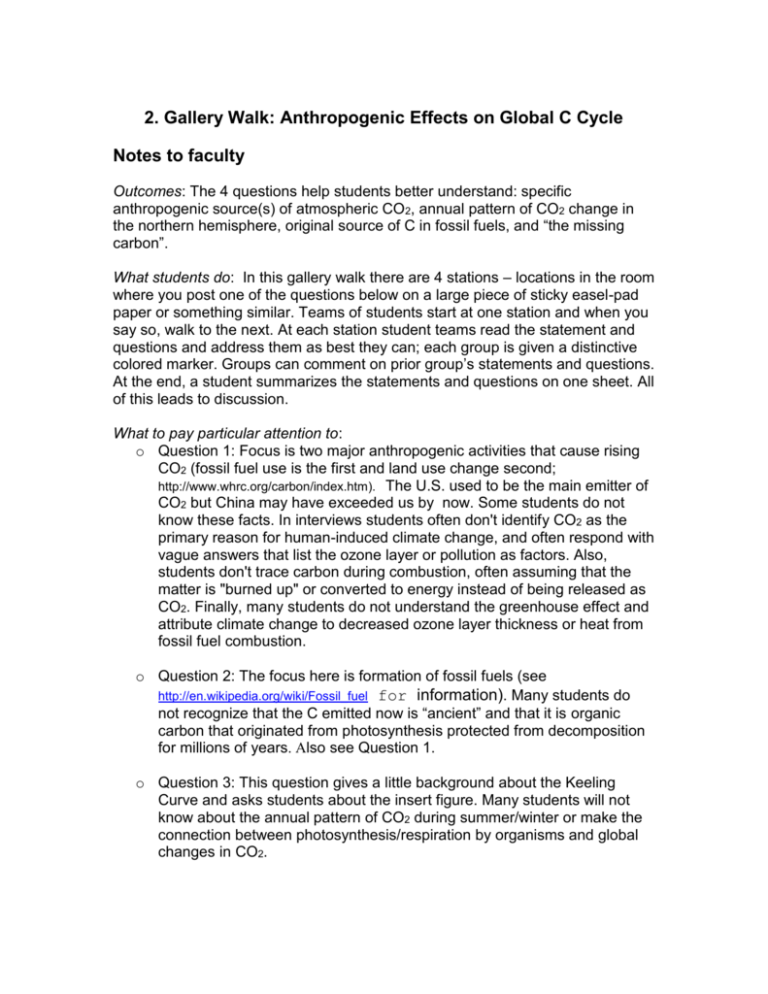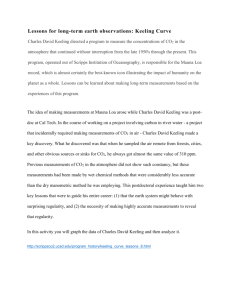2. CD_Technology_Gallery_Walk
advertisement

2. Gallery Walk: Anthropogenic Effects on Global C Cycle Notes to faculty Outcomes: The 4 questions help students better understand: specific anthropogenic source(s) of atmospheric CO2, annual pattern of CO2 change in the northern hemisphere, original source of C in fossil fuels, and “the missing carbon”. What students do: In this gallery walk there are 4 stations – locations in the room where you post one of the questions below on a large piece of sticky easel-pad paper or something similar. Teams of students start at one station and when you say so, walk to the next. At each station student teams read the statement and questions and address them as best they can; each group is given a distinctive colored marker. Groups can comment on prior group’s statements and questions. At the end, a student summarizes the statements and questions on one sheet. All of this leads to discussion. What to pay particular attention to: o Question 1: Focus is two major anthropogenic activities that cause rising CO2 (fossil fuel use is the first and land use change second; http://www.whrc.org/carbon/index.htm). The U.S. used to be the main emitter of CO2 but China may have exceeded us by now. Some students do not know these facts. In interviews students often don't identify CO2 as the primary reason for human-induced climate change, and often respond with vague answers that list the ozone layer or pollution as factors. Also, students don't trace carbon during combustion, often assuming that the matter is "burned up" or converted to energy instead of being released as CO2. Finally, many students do not understand the greenhouse effect and attribute climate change to decreased ozone layer thickness or heat from fossil fuel combustion. o Question 2: The focus here is formation of fossil fuels (see http://en.wikipedia.org/wiki/Fossil_fuel for information). Many students do not recognize that the C emitted now is “ancient” and that it is organic carbon that originated from photosynthesis protected from decomposition for millions of years. Also see Question 1. o Question 3: This question gives a little background about the Keeling Curve and asks students about the insert figure. Many students will not know about the annual pattern of CO2 during summer/winter or make the connection between photosynthesis/respiration by organisms and global changes in CO2. o Questions 4: This is the most challenging question. The figure is unusual in its set up, both in regard to the accumulation/release axis and the stacked data. Most students won’t know what the “missing C” is, but this will give them a chance to puzzled over it. Logistics: o A Gallery Walk is a good way to find out fairly quickly what students know about a specific topic. This would give you an idea how much you need to go over in class and particular points of confusion or misunderstanding. The questions are related but independent of each other (e.g. students don’t need to have read no. 1 before no. 2). The SERC URL below gives detailed instructions. o You can print out the questions and attach them to the sheets. You may need to add extra sheets of paper as student comments fill them up, so be prepared for this. o You can do this exercise with a small class. Groups can be a small as 2 but should not be larger than 5. Have student count off the 4; 1s go to the first station and so on. In a medium sized class you can have multiple stations of the same questions if you figure out the logistics of moving that many students around. o You have to figure out logistical issues ahead of time such as keeping students on task and in general be comfortable with an “uncontrolled” exercise like this (e.g. it will be noisy). It will be new to most students and therefore you need to explain the “rules”. Many students like it because it gives them a chance to walk around and work in groups in a different way. o In classes too large to do a Gallery Walk, you can use any of the figures in discussion, as homework, a minute paper, etc. Resources: o Gallery Walk (http://serc.carleton.edu/introgeo/gallerywalk/how.html; http://serc.carleton.edu/introgeo/gallerywalk/) and http://tiee.ecoed.net/teach/teach_glossary.html o Woods Hole Research Center Global C Cycle (http://www.whrc.org/carbon/index.htm) o Nature Report on Missing C (http://www.nature.com/climate/2007/0708/full/climate.2007.35.html) Units & Quantitative Skills: Figure interpretation; units for carbon dioxide, global carbon (Pg); C flux – what this means Topics specific to the exercise: Missing carbon; global C measurements; Keeling Curve; land use change effects on C cycling. HIDDEN CURRICULUM • Principles: Conservation of Matter: Carbon is conserved and can be traced throughout the global C cycle. • Processes: Generation (photosynthesis as ultimate source of C in fuels); Transformation; Oxidation (e.g. fossil fuel oxidation). • Scale & Time: links between atomic/molecular, cellular-organismal, and ecosystem level processes in the global C cycle; processes over a month vs. a year; global measurements as integrators of regional processes • Forms & Representations: Global carbon flow; organic molecules as form of potential chemical energy. Student Directions Gallery Walk: Follow your teacher’s instructions to address the following questions: 1. We know from measurements taken in Hawaii at Manua Loa that Carbon Dioxide (CO2) 38 concentrations have increased greatly since the 1960s – from about 315 ppm to about 390 ppm now. This is of great concern because CO2 is a greenhouse gas and contributes to global warming. Which two countries do you think are mainly responsible for this rapid increase in CO2? What human activities do you think is responsible for this increase? Explain the process here – exactly how this activity results in CO2 going into the atmosphere. Be as specific as you can be and write down any questions you have. 2. When fossil fuels are burned for various uses, CO2 is released into the atmosphere. What are fossil fuels? Where did the C in the CO 2 come from in the first place and by what biological process? Be as specific as you can be and write down any questions you have. 3. This is the well know Keeling Curve named after Charles Keeling, a scientist from the Scripps Institution of Oceanography who started taking measurements of atmospheric CO2 in Hawaii in1958. Clearly atmospheric CO2 has increased during the period shown here. Explain the inserted graph in the lower right and its relationship to the main curve. Write down any questions you may have. Source: http://en.wikipedia.org/wiki/Keeling_Curve 4. This graph shows yearly estimates of global flux (rate of change) of Carbon (units are Pg, Petagrams or 1,000,000,000,000,000 or 1X10 12 grams) from various sources. First, make sure you understand the graph (the axes, each category). Then interpret it. In particular, what is the “unidentified sink”? What is a carbon sink – what does this mean? Be as specific as you can be and write down any questions you have. Source: http://www.whrc.org/carbon/images/Flux_of_Carbon.gif






